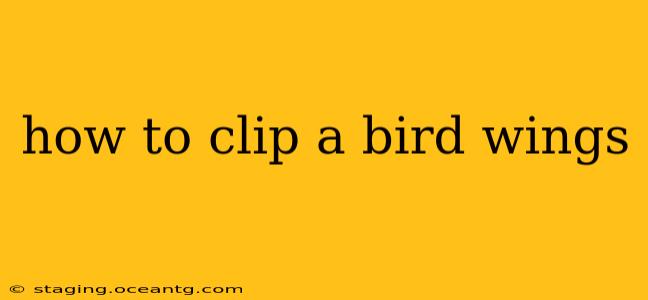How to Clip a Bird's Wings: A Guide for Responsible Bird Owners
Clipping a bird's wings, also known as wing trimming or pinioning, is a procedure that reduces a bird's ability to fly. It's a common practice for pet birds, particularly those kept indoors, to prevent accidental escapes and injuries. However, it's crucial to understand that this is a significant decision with ethical considerations, and should only be undertaken by experienced individuals or a qualified avian veterinarian. Improper wing clipping can severely injure your bird. This guide provides information for educational purposes only; it does not replace professional veterinary advice.
Before you begin, consider the alternatives:
- Indoor Aviary: Providing a large, secure indoor aviary can offer a safe space for your bird to exercise its wings without the risk of escape.
- Training and Recall: Consistent training can help teach your bird to return to its owner, reducing the need for wing clipping.
- Harnesses and Leads: These can allow for supervised outdoor flights.
If you've considered these alternatives and still believe wing clipping is necessary, proceed with extreme caution. Never attempt to clip your bird's wings without proper training and understanding.
What You'll Need:
- Sharp, clean avian-specific nail clippers or small, sharp scissors: Regular human nail clippers are unsuitable. Blunt tools can cause crushing injuries.
- Soft towel or blanket: To safely restrain your bird.
- Treats: To reward your bird for good behavior and to help calm them.
- Someone to help: Having a second person to assist can make the process significantly safer and easier.
How to Clip Your Bird's Wings Safely:
- Proper Restraint: Wrap your bird securely in a soft towel, leaving its head and wings exposed. Speak to your bird in a calming voice.
- Identifying the Flight Feathers: Carefully examine your bird's wings. The longest primary flight feathers are located on the outer edge of the wing. These are the feathers you will be trimming.
- Clipping the Feathers: Hold the wing firmly but gently. Clip only the tips of the primary flight feathers. Do not cut the feather shafts completely. A good rule of thumb is to trim approximately one-third to one-half of the feather's length. Aim for an even trim across all the feathers to avoid imbalance.
- Checking for Bleeding: If you accidentally cut the feather shaft too deeply and bleeding occurs, apply styptic powder (available at pet supply stores) to stop the bleeding.
- Post-Clip Observation: Monitor your bird closely for any signs of discomfort or injury.
Should I clip my bird's wings myself or seek professional help?
It is highly recommended to consult an avian veterinarian or an experienced bird handler for wing clipping. They have the expertise to correctly and safely perform the procedure, minimizing the risk of injury.
How often should I clip my bird's wings?
Birds' feathers naturally molt, so wing clippings need to be repeated every few months, depending on the growth rate of your bird's feathers. Regular trimming helps maintain the desired level of flight restriction.
What are the risks of wing clipping?
Improper wing clipping can lead to various complications, including:
- Bleeding: Cutting into the feather shaft too deeply can cause significant bleeding.
- Infection: Contamination of the clipped area can lead to infection.
- Pain and discomfort: Incorrect technique can cause pain to your bird.
- Impaired balance and coordination: Uneven clipping can lead to difficulty with landing and balance.
- Long-term psychological effects: Some birds may experience stress and anxiety due to restricted flight.
Can I clip my bird's wings at home?
While technically possible, it’s strongly discouraged unless you have extensive experience with avian care and wing clipping. Improper techniques can result in injury or even death for your feathered friend.
Remember, a bird's ability to fly is crucial for its physical and mental well-being. Wing clipping should only be considered a last resort and only after carefully weighing the pros and cons with a professional avian veterinarian. The health and well-being of your bird should always be your top priority.
